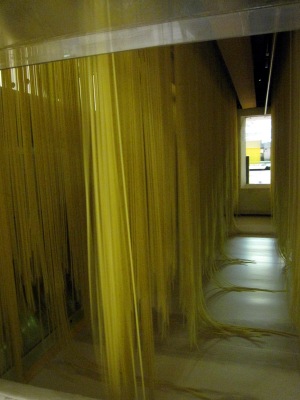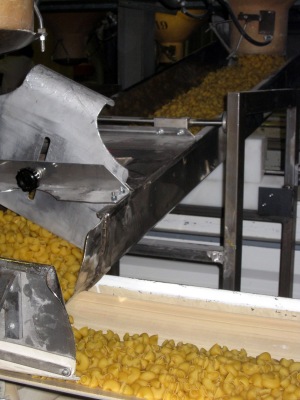Do you know what Italian company was single-handedly responsible for changing the texture of America’s pasta?
Barilla was founded in 1877 by Pietro Barillo Sr., who began the business as a simple pasta shop in Parma. The company is now on its fourth generation of family owners, and has been almost continuously privately owned, save for a gap in the ‘70s when Barilla was bought out by U.S. multinational W.R. Grace. In 1990, Barilla began aggressively expanding into international markets, through the acquisition of local pasta companies and the development of manufacturing plants abroad. This included the creation of the first American plant in Ames, Iowa in 1999, with a second plant following in upstate New York.
Today, Barilla is the world’s largest pasta corporation, and the largest producer of baked goods in Italy, with sales in 2010 totaling €4.535 billion. The firm encompasses over 20 brands, exports to 125 countries, and holds 16,000 employees. They are also the single largest buyer of durum wheat in the world, and consequently, a major player in the supply chain, able to set price and quality demands.
Academia Barilla was founded in 2004 to promote Italian food culture throughout the world. (Wait, I’ve heard this before…) Those familiar with Italian will note that “academia” seems to be missing a letter (the usual spelling is “accademia”), but as Academia Barilla President Gianluigi Zenti explained to us, the spelling is actually taken from Latin, and harks back to the Platonic ideal of food as a key component of the quality of life.
Advertising itself as the pillars of “culture, heritage, authenticity and experience,” the Academia is an Italian culinary and travel experience, combined with a demonstration of traditional Italian food products sold by Barilla. Participants include chefs, business professionals, and Italophile food lovers, who arrive in Parma for courses on everything from egg pastas and risottos, to Italian Jewish cuisine and sugar sculpture work. You can also tour vineyards and travel to other parts of Italy, take part in team-building exercises and hold conferences at the Academia. “If you ask foreigners to name regions in Italy, they will probably only be able to say Tuscany, and if they are very clever, Sicily,” said Zingeri. In this way, the mostly non-Italian audience is educated about regional Italian cuisines and products.
The understated gem of Academia Barilla is the Gastronomic Library, a collection of over 9,000 volumes of food-related literature, spanning from the 16th century to modern times. The holdings also include 4,750 historic menus, a colorful depiction of what it was like to eat as an aristocrat in bygone times. Most of the books are focused on Italian and European gastronomy, but there are some offerings on American and Asian cuisines. I stumbled across a Chinese cookbook written by an Italian from the ’70s, with amusingly bad Italian transliterations. There was also a book of Harry Potter recipes, and a book of dishes inspired by Beatles songs (“Love Me Do” fondue, “Fool on the Hill” salmone al dill, “Ob-la-di, Ob-la-da” frittata). The library is open to the public, though it has typically limited Italian-style hours. It is only open on Wednesday mornings and the books cannot be checked out.
After a lunch buffet of mostly non-pasta, we trooped off to tour the original Barilla factory. Built in 1917, this is the oldest Barilla plant in existence, and includes 19 different pasta-making lines. Each line specializes in a category of pasta (soup pasta, short pasta, long pasta), and produces about 6 tons of pasta an hour. The factory runs for 3 shifts a day, 6 days a week, excluding Sundays. On average, the shape of the pasta is changed once every shift, and it only takes 6-10 minutes to reprogram the manufacturing line for a new pasta shape.
[youtube=http://www.youtube.com/watch?v=sel9fDEejJI]
Inside the factory, the warm, sticky smell of boiling pasta filled my nose. With a loud hum, machinery mixed semolina by the ton with water to make dough, kneading it for 10-12 minutes. The dough is then extruded through pasta dies, dried for 9 hours and packaged in the distinctive dark blue boxes of Barilla.
To get from one end of the sprawling complex to another, workers use bicycles between the rows of machinery. In this way, you can travel around the globe’s stomach in a matter of minutes. The recipes for pasta sold in Italy and the US are the exactly the same except for one respect; the FDA requires that pasta sold in the US be fortified with folic acid and other nutrients. Lasagna is also packaged in a different format for US markets. In Europe, lasagna sheets are simply sold by weight in 500 g portions. American consumers, on the other hand, prefer 16 uniform sheets that fit evenly into a lasagna pan to make dinner for four people. Overall, 40% of Barilla’s sales are domestic, and the remaining 60% take place abroad.
Increasing globalization poses a challenge for a company that wants to retain its “Italian soul” and face as the ambassador of Italian cuisine. For a different perspective, Zingeri related some of his experiences in trying to crack the US market. When he first arrived in 1994, he was told that the American market was already saturated with pasta brands, which all boasted Italian-sounding names. At that time, pasta was made not with hard durum wheat, but with soft wheat, or a mixture of soft and durum wheats. “They told me, ‘Americans don’t want pasta made with durum wheat, they want pasta that can be cooked in 3 minutes, and when you throw it on the wall, it sticks,'” said Zingeri. “They said, ‘We’re American, we invented marketing.’ And then they told me that the name was not good. Barilla? Gorilla? It was too difficult to pronounce. I went back to Italy and wondered if it would be easier to be reassigned to Australia.”
Undeterred, Zingeri forged ahead with the promotion of durum wheat pasta in the US, with the result that in just five years Barilla became the top-selling pasta brand in the country. “If you hear them tell you, ‘Give customers what they want,’ that is actually a big business opportunity,” said Zingeri. “What we sell in the US is exactly what we sell in Italy.”
What about the sauces? Here, Zingeri admitted to compromising. American products tend to be heavily saturated with salt, fat and sugar, and thus consumers expect products laden with these additives. “We did not have the same courage with sauce,” Zingeri said, “so we custom-made recipes according to US tastes. The sauces were sweeter, and very heavy on garlic.” Zingeri paused for a moment to reflect. “Look, we had no success here. Barilla holds only a 3% share of the ready-made sauce market, but 30% of the pasta market. Compared to Ragu, Prego, and everyone else, our sauces all taste the same. It took us 10 years to figure that out, but now we are reformulating our sauces to be the same as the Italian versions.”
Turns out that pasta is not so boring after all.






Hello! I enjoyed reading about your factory visit. How did you organize it? Thank you!
Hi Johanna, thanks for reading! This trip was organized as part of the University of Gastronomic Sciences masters program. You may be able to contact Barilla for a tour on your own, or for more information on the university program, you can browse the rest of this blog.